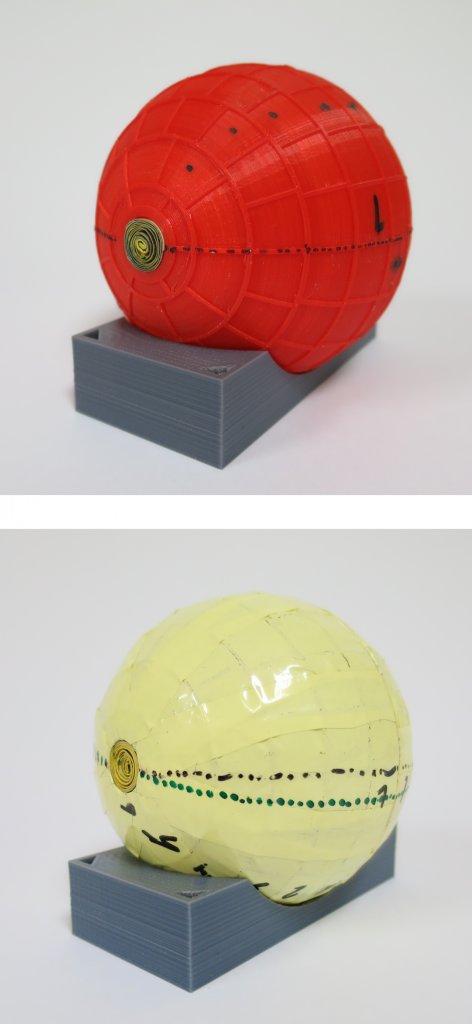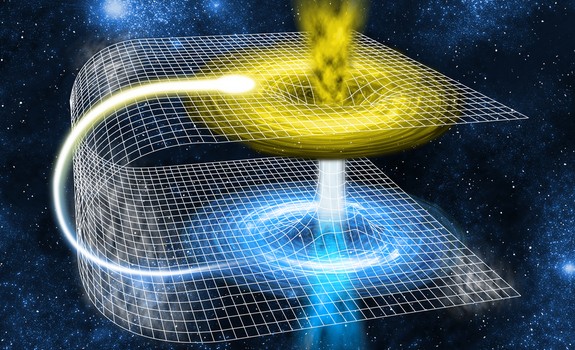Electromagnetic Wormholes: An Invisible Tunnel For Magnets
Gravitational wormholes are popularized by Sci-Fi movies and may be understood loosely as a ‘shortcut’ between two points in space-time. The very belief that the universe may not be strictly planar gives birth to such an idea.

Curvatures in space and time dimensions can bridge connections between two seemingly “far” points in the universe through a shorter path, the wormhole. Photo credit: edobric | shutterstock | space
Wormholes were first proposed by Albert Einstein and Nathan Rose in 1935. Dr. Einstein first theorized that every object creates an imprint on the universe by deforming the reality – space and time – around it, resulting in gravitational pulls among objects. The two scientists then concluded that a wormhole is a special type of deformation that has been warped in a way to connect two different points in space-time.
But the construction of gravitational wormholes isn’t nearly as straightforward.
As Professor Àlvar Sànchez from the Universitat Autònoma de Barcelona explains, large amounts of negative gravitational energy would be required to generate such a wormhole, which makes impossible its realization with present technology. But, as the team leader of the Superconductivity Group at UAB adds, we can aim to do something more modest: create an undetectable tunnel for the magnetic field between two points, an electromagnetic (EM) wormhole.
Indeed, researchers in Professor Sanchez’s lab group have recently created, in the laboratory, the first experimental wormhole that can connect two regions of space, magnetically. The result of their success is documented in their scientific report published in Nature.

From left to right, Alvaro Sanchez, Carles Navau and Jordi Prat-Camps, lead authors of A Magnetic Wormhole paper. (Credit: Jordi Prat-Camps and Universitat Autònoma de Barcelona; permission is granted for NPG and external media to use the figure.)
Magnetic wormholes
According to their report, the magnetic wormhole is an analogy of gravitational ones as it changes the topology of space; the object created will make it seem as if its inner region has been magnetically erased from its surrounding 3D space. This class of wormholes was first proposed by Professor Allan Greenleaf from the University of Rochester in New York and his colleagues in Washington, UK, and Finland. Though they won’t enable time and space travel for people, undetectable magnetic pathways could play a vital role in medical applications. Unlike their gravitational counterparts, these wormholes can be simulated and tested.
Previous construction efforts involve building “cloaks” for electromagnetic waves using transformation optics and scattering cancellation. But, as the Barcelona’s university researchers note, the cloak doesn’t apply to large objects, thus limiting the size of the wormhole. In order to expand this limit, the group has chosen to use metamaterials to hide their wormhole instead.
“We take advantage of the possibilities that magnetic metamaterials offer for shaping static magnetic fields. It would use bulk metamaterials with complicated permeability and permittivity parameters.”
Their wormhole, in the shape of a sphere, is made magnetically undetectable by carefully selecting the properties of the two layers composing it. In such a way, explains Professor Sanchez, the magnetic signature of one of the layers exactly cancels the signature of the other one, achieving the desired invisibility.

(Left) 3D sketch of the magnetic wormhole, showing how the magnetic field lines (in red) of a small magnet at the right are transferred through it. (Right) From a magnetic point of view the wormhole is magnetically undetectable so that the field of the magnet seems to disappear at the right and reappear at the left in the form of a magnetic monopole. (Credit: Jordi Prat-Camps and Universitat Autònoma de Barcelona; permission is granted for NPG and external media to use the figure.)
When properly constructed, a magnet passing through the sphere will appear to have come out of nowhere, magnetically speaking. But to pass as a magnetic wormhole, the designed sphere needs to pass several tests:
- The interior of the sphere needs to be magnetically decoupled — separated — from its surrounding 3D environment
- The exterior of the sphere cannot be detected magnetically
- Magnetic fields must be able to propagate through the sphere’s interior
The research group has specifically selected their metamaterials to fulfill the required conditions. In short, they’ve created a shell made with a superconducting metamaterial, which has the property of “shielding” its interior volume magnetically. Then, by adding a ferromagnetic layer outside the shell, they are able to make the exterior undetectable magnetically. Furthermore, the global magnetic response can be effectively cancelled through thinning the ferromagnetic layer. The final design is a spherical bilayer composed of the superconducting and ferromagnetic layers with certain radiuses and permeability condition that is capable of cloaking a uniformly applied magnetic field.
The final question is will the wormhole transport electromagnetic waves efficiently?
Yes, it can, says the team.
In traditional models, magnetic fields tend to decay over long distances, but the team has come up with an effective solution by inserting a thin ferromagnetic sheet wound into a spiral to yield a good magnetic field transfer for long distance travel.
The result is just what the researchers hoped for — a cloaked wormhole for electromagnetic waves.

(Top) Superconducting layer surrounded by the plastic former to hold the ferromagnetic pieces. (Bottom) Final aspect of the wormhole including a plastic protection in yellow. (Credit: Jordi Prat-Camps and Universitat Autònoma de Barcelona; permission is granted for NPG and external media to use the figure.)
According to the researchers, the sphere with all materials activated indeed shows an excellent cloaking behavior allowing clear transmission of magnetic field through its inner spiral, forming a magnetic wormhole that creates an illusion of a magnetic field coming out of nowhere.
Professor Sanchez and his colleagues are hopeful that their recent success is a leap forward towards possible applications in which magnetic fields are used, in medicine for example; technologies utilizing magnetic wormholes could increase patients’ comfort by distancing them from magnetic detectors. As the researchers elaborate, essentially any devices requiring the local application of magnetic fields in an undistorted background could leverage their sphere.
It looks like this is one wormhole open for (magnetic) travel. We wish the team great success in their upcoming designs and look forward to more futuristic technologies such as this.
Paper cited: A Magnetic Wormhole – Nature











